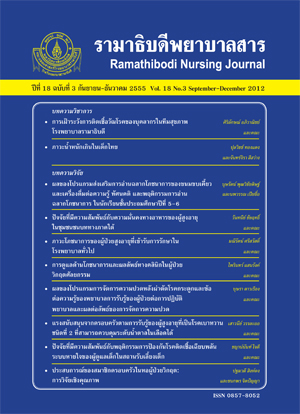การดูแลด้านโภชนาการและผลลัพธ์ทางคลินิกในผู้ป่วยวิกฤตศัลยกรรม
Main Article Content
Abstract
บทคัดย่อ
การวิจัยเชิงบรรยายครั้งนี้มีวัตถุประสงค์เพื่อศึกษาการดูแลด้านโภชนาการและผลลัพธ์ ทางคลินิก (จำนวนวันนอนโรงพยาบาล จำนวนวันนอนในหอผู้ป่วยวิกฤต จำนวนวันที่ใช้เครื่องช่วยหายใจ อัตราการติดเชื้อ และอัตราการตาย)ในผู้ป่วยวิกฤตศัลยกรรม กรอบแนวคิดในการวิจัยได้จากการทบทวนวรรณกรรม โดยเลือกกลุ่มตัวอย่างแบบเฉพาะเจาะจง ซึ่งเป็นผู้ป่วยที่เข้ารับการรักษาในหอผู้ป่วยวิกฤตศัลยกรรมอย่างน้อย 2 วัน ในปี พ.ศ. 2553 จำนวน 205 ราย เก็บรวบรวมข้อมูลด้วยแบบบันทึกข้อมูล โดยบันทึกข้อมูลย้อนหลังจากเวชระเบียน วิเคราะห์ข้อมูล โดยใช้สถิติบรรยายไคสแควร์ และแมนวิทนียู ผลการวิจัยพบว่า กลุ่มตัวอย่างได้รับการดูแลด้าน โภชนาการตามแนวทางของสมาคมผู้ให้อาหารทางหลอดเลือดดำและทางเดินอาหารแห่งสหรัฐอเมริกาและยุโรป เริ่มให้อาหารหลังผ่าตัดเร็ว (ภายใน 48 ชั่วโมง) ร้อยละ 46.3 ให้อาหาร ทางปากร้อยละ 56.1 ทางสายให้อาหารร้อยละ 23.9 ให้อาหารทางหลอดเลือดดำร้อยละ 1 และ ให้ร่วมกันหลายวิธีร้อยละ 14.1 พบอาการแทรกซ้อนของระบบทางเดินอาหารร้อยละ 44.4 ท้องผูกร้อยละ 31.4 ปริมาณอาหารเหลือค้างในกระเพาะอาหารมากร้อยละ 10.3 ค่ามัธยฐาน ของจำนวนวันนอนโรงพยาบาล 13 วัน จำนวนวันนอนในหอผู้ป่วยวิกฤต 4 วัน จำนวนวันที่ใช้ เครื่องช่วยหายใจ 3 วัน อัตราการติดเชื้อร้อยละ 36 และอัตราการตายร้อยละ 12.2 กลุ่มที่มีระยะ เวลาเริ่มให้อาหารเร็ว มีจำนวนวันนอนโรงพยาบาล จำนวนวันนอนในหอผู้ป่วยวิกฤต จำนวนวันที่ ใช้เครื่องช่วยหายใจ และอัตราการติดเชื้อน้อยกว่ากลุ่มที่มีระยะเวลาเริ่มให้อาหารช้าอย่างมีนัย สำคัญทางสถิติ แต่อัตราการตายไม่แตกต่างกันอย่างมีนัยสำคัญทางสถิติ และกลุ่มที่มีระยะเวลา ที่ให้อาหารได้ตามเป้าหมายเร็ว (ภายใน 7 วัน) มีผลลัพธ์ทางคลินิกดีกว่ากลุ่มที่มีระยะเวลาให้ อาหารได้ตามเป้าหมายช้า (มากกว่า 7 วัน) อย่างมีนัยสำคัญทางสถิติ
คำสำคัญ: การดูแลด้านโภชนาการ ผลลัพธ์ทางคลินิก ผู้ป่วยวิกฤตศัลยกรรม
Abstract
The purposes of this descriptive research were to explore nutrition support and clinical outcomes (length of hospital stay, intensive care unit [ICU] stay, days on mechanical ventilation, infection, and mortality) in critically ill surgical patients. A literature review was used to develop a conceptual framework for this study. Purposive sampling was used to recruit a sample of 205 cases, who had been admitted to the surgical ICU and had an ICU stay at least two days from January to December 2010. Data record forms were collected retrospectively from medical records. The data were analyzed using descriptive statistics, Chi-square, and Mann Whitney U tests. The results showed that the sample group received nutrition support as recommended by the American Society for Parenteral and Enteral Nutrition and the European Society for Parenteral and Enteral Nutrition. Most of the sample (46.3%) received early enteral nutrition (EN) within 48 hours of surgery; 56.1% of patients were fed by mouth; 23.9% received tube feeding; 1% received parenteral nutrition (PN); and 14% received a combination of EN and PN. The gastrointestinal complication rate was 44.4%; constipation was 31.7%; and high residual gastric content was 10.3%. The median length of hospital stay was 13 days; ICU stay was 4 days; days on mechanical ventilation were 3 days. Postoperative infection and mortality rates were 36% and 12.2%, respectively. Associations between nutrition support and clinical outcomes were found. The early EN and late EN patients had significantly different lengths of hospital stay, ICU stay, days on mechanical ventilation, and infection rates, but the mortality rate was not significantly different. The group with achieved early EN goals had significantly better clinical outcomes compared with those who achieved late goals of feeding.
Keywords: Nutritional support, Clinical outcomes, Surgical critical patients
Article Details
บทความ ข้อมูล เนื้อหา รูปภาพ ฯลฯ ที่ได้รับการตีพิมพ์ในรามาธิบดีพยาบาลสาร ถือเป็นลิขสิทธิ์ของวารสาร หากบุคคลหรือหน่วยงานใดต้องการนำทั้งหมดหรือส่วนหนึ่งส่วนใดไปเผยแพร่หรือเพื่อกระทำการใด ใด จะต้องได้รับอนุญาตเป็นลายลักษณ์อักษรจากรามาธิบดีพยาบาลสารก่อนเท่านั้น


